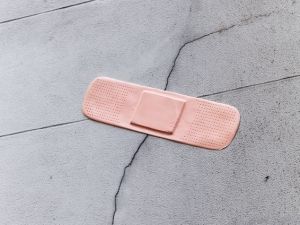New self-healing plastics developed
Scratches in the car finish or cracks in polymer material: Self-healing materials can repair themselves by restoring their initial molecular structure after the damage. Scientists of the Karlsruhe Institute of Technology and Evonik Industries have developed a chemical crosslinking reaction that ensures good short-term healing properties of the material under mild heating. The research results have now been published in the Advanced Materials journal.

KIT’s self-healing materials do not need any band-aid, as they can restore their molecular structure.
Günter Menzl – Fotolia
The KIT group headed by Christopher Barner-Kowollik uses the possibility of crosslinking functionalized fibers or small molecules by a reversible chemical reaction for the production of self-healing materials. These so-called switchable networks can be decomposed into their initial constituents and reassembled again after the damage. The advantage is that the self-healing mechanism can be initiated any time by heat, light or by the addition of a chemical substance. “Our method does not need any catalyst, no additive is required,” Professor Barner-Kowollik says. The holder of the Chair for Preparative Macromolecular Chemistry at KIT studies syntheses of macromolecular chemical compounds.
It took about four years of research for the working group of Barner-Kowollik, together with the Project House Composites of Creavis, the strategic innovation unit of Evonik, to develop a novel polymer network. At comparably low temperatures from 50°C to 120°C, the network exhibits excellent healing properties within a few minutes. Reducing the time needed for healing and optimizing the external conditions, under which the healing process takes place, are the major challenges of research relating to self-healing materials. Using the healing cycle developed by them, the KIT researchers have found a large number of intermolecular compounds that close again within a very short term during cooling. Mechanical tests, such as tensile and viscosity tests, confirmed that the original properties of the material can be restored completely. “We succeeded in demonstrating that test specimens after first healing were bound even more strongly than before,” Barner-Kowollik says.
The self-healing properties can be transferred to a large range of plastics known. Apart from self-healing, the material is given another advantageous property: As flowability is enhanced at higher temperatures, the material can be molded well. A potential field of application lies in the production of fiber-reinforced plastics components for automotive and aircraft industries.
Original publication
Other news from the department science

Get the chemical industry in your inbox
By submitting this form you agree that LUMITOS AG will send you the newsletter(s) selected above by email. Your data will not be passed on to third parties. Your data will be stored and processed in accordance with our data protection regulations. LUMITOS may contact you by email for the purpose of advertising or market and opinion surveys. You can revoke your consent at any time without giving reasons to LUMITOS AG, Ernst-Augustin-Str. 2, 12489 Berlin, Germany or by e-mail at revoke@lumitos.com with effect for the future. In addition, each email contains a link to unsubscribe from the corresponding newsletter.




























































